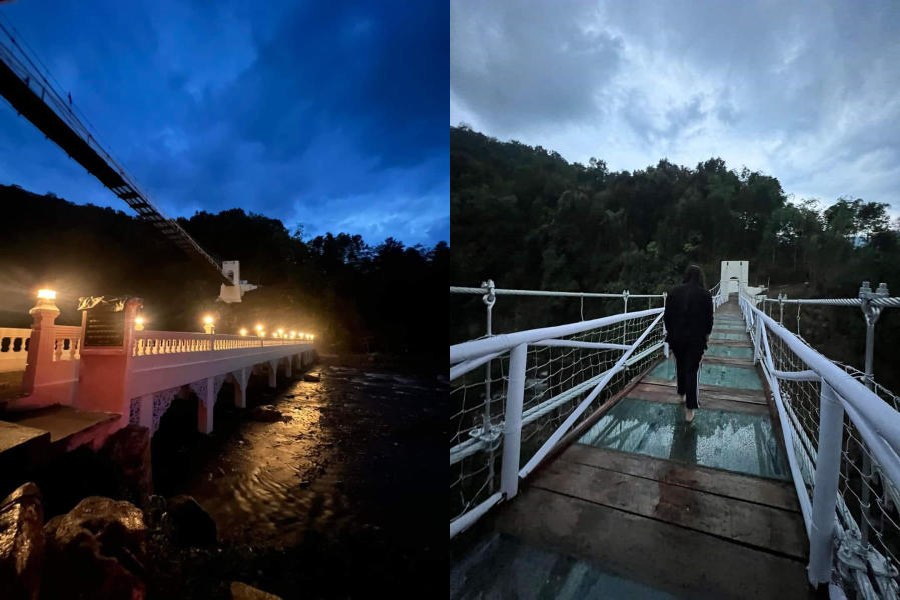A 130-foot-long motorable bridge and a 160-foot-long suspension-bridge-turned skywalk built largely through voluntary contribution of labour by hundreds of people over a span of seven months were inaugurated in Darjeeling on Sunday.
Ajoy Edwards, the president of the Hamro Party (HP), contributed the lion’s share of the project by pumping in more than ₹35 lakh. Others also chipped in amounts.
“We cannot estimate the cost of the project as hundreds of people provided free labour over seven months. Imagine the amount if we had to pay for the labour,” Edwards said after inaugurating the bridge.
Residents of 20 villages in the Singtom-Bijanbari area in Darjeeling collaborated under the banner of the Balwabas Pul Nirman Committee for the skywalk and concrete bridge. Singtom and Bijanbari are two valleys separated by the Chota Rangit river over which the bridges have been built.
The place where the skywalk and the bridge have come up is about 8km from Darjeeling town.
During the British era, people travelled to Darjeeling from Bijanbari and vice versa on foot or by horse via the suspension bridge.
With motor vehicles becoming popular, the demand for a concrete bridge grew louder almost 40 years ago. The bridge cuts the travel time between Bijanbari and Darjeeling by nearly an hour. The other routes that connect Darjeeling with Bijanbari are via Ghoombhanjyang and Jamuni and are circuitous.
However, politics came in the way of the new bridge in the 1980s.
Singtom, Pulbazar and Bijanbari were dominated by supporters of the CPM when the Subash Ghisingh-led Gorkha National Liberation Front (GNLF) spearheaded a movement for the separate state in 1986.
Clashes between the supporters of the CPM and the GNLF were frequent in those areas then.
The GNLF swept the elections held for the Darjeeling Gorkha Hill Council (DGHC) for the first time in 1988. However, the Chungthung-Marybong and Pulbzar-Bijanbari seats went to the CPM.
“In 1992, the (CPM-led) state government wanted to construct a bridge over the river at an approximate cost of ₹2 crore. Despite laying the foundation stone, the project could not start as the DGHC did not provide the no-objection certificate,” said Saran Gurung, a resident of the area.
Gurung had joined the people’s initiative for the skywalk and the motorable bridge because Edwards had termed the endeavour “apolitical”.
In the late 1990s, CPM MP S.P. Lepcha, a resident of Singtom, sanctioned an amount to build the bridge under the MPLAD funds.
“The government erected three pillars but that was it. There was no further progress,” said Gurung who contributed more than ₹2 lakh to the people’s project.
While the motorable bridge was being completed, Edwards and the committee decided to work on the bridge hanging 200 feet above the river.
“We thought of converting the suspension bridge into a skywalk with glass flooring so that it could be a tourist attraction. We would like to encourage bike taxis to bring tourists here. This will ensure that there is no traffic congestion along the road,” said Edwards.
The bridge has a glass bottom for a stretch of 30 feet in the middle. “We are using 12mm tuffen glasses,” Edwards had said earlier.
Tuffen glasses are toughened tempered safety glasses that are much stronger than the normal glasses used in household construction.
The committee has decided not to allow more than 10 people together to cross the bridge as a precautionary measure.
The team also plans to construct a coffee house using the three unfinished pillars. “This, too, would be a tourist attraction and help local people economically,” said Edwards.
The project is being christened Tin Pul (three bridges).
Edwards was visiting the place distributing relief during the Covid-19 pandemic when local people raised the demand for the concrete bridge. He promised to contribute raw materials to build the bridge.
Early this year, the residents approached Edwards and volunteered to contribute labour for free.










